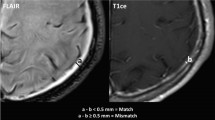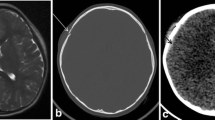Abstract
Introduction
Rapid MRI with ultrafast T2 sequences can be performed without sedation and is often used in place of computed tomography (CT) to evaluate pediatric patients for indications such as hydrocephalus. This study investigated the sensitivity of rapid magnetic resonance imaging (MRI) for detection and follow-up of acute intracranial hemorrhage in comparison to CT, which is commonly the first-line imaging.
Methods
Patients presenting to a pediatric hospital with acute intracranial hemorrhage on CT and follow-up rapid MRI within 48 h were included. Rapid MRI studies consisted of three plane ultrafast T2 sequences either with or without axial gradient echo (GRE) sequences. Identification of hemorrhage on rapid MRI was assessed by readers both blinded and unblinded to prior CT results.
Results
One hundred two acute hemorrhages in 61 patients were identified by CT. Rapid MRI detection of subdural and epidural hemorrhages was modest in the absence of prior CT for comparison (sensitivity 61–74 %), but increased with review of the prior CT (sensitivity 80–86 %). Hemorrhage size was a significant predictor of detection (p < 0.0001). Three plane fast T2 images alone without GRE sequences were poor at detecting subarachnoid hemorrhage (sensitivity 10–25 %); rapid MRI with GRE sequences identified the majority of subarachnoid hemorrhage (sensitivity 71–93 %). GRE modestly increased detection of other extra-axial hemorrhages.
Conclusions
Rapid MRI with GRE sequences is sensitive for most acute intracranial hemorrhages only when a prior CT is available for review. Rapid MRI is not adequate to replace CT in initial evaluation of intracranial hemorrhages but may be helpful in follow-up of known hemorrhages.






Similar content being viewed by others
References
Datta S, Stoodley N, Jayawant S, Renowden S, Kemp A (2005) Neuroradiological aspects of subdural haemorrhages. Arch Dis Child 90:947–951
Kemp AM, Rajaram S, Mann M et al (2009) What neuroimaging should be performed in children in whom inflicted brain injury (iBI) is suspected? A systematic review. Clin Radiol 64:473–483
Pearce MS, Salotti JA, Little MP et al (2012) Radiation exposure from CT scans in childhood and subsequent risk of leukaemia and brain tumours: a retrospective cohort study. Lancet 380:499–505
Kidwell CS, Chalela JA, Saver JL et al (2004) Comparison of MRI and CT for detection of acute intracerebral hemorrhage. JAMA 292:1823–1830
Roguski M, Morel B, Sweeney M et al (2015) Magnetic resonance imaging as an alternative to computed tomography in select patients with traumatic brain injury: a retrospective comparison. J Neurosurg Pediatr 15:529–534
Liang L, Korogi Y, Sugahara Y et al (1999) Detection of intracranial hemorrhage with susceptibility-weighted MR sequences. AJNR 20:1527–1534
Buttram SD, Garcia-Filion P (2015) Computed tomography vs magnetic resonance imaging for identifying acute lesions in pediatric traumatic brain injury. Hosp Pediatr 5:79–84
Niederhauser BD, McDonald RJ, Keating GF et al (2013) Retrospective review of rapid pediatric brain MR imaging at an academic institution including practice trends and factors affecting scan times. AJNR 2013:1836–1840
Ashley WW, McKinstry RC, Leonard J, Smyth MD, Lee BC, Park TS (2015) Use of rapid-sequence magnetic resonance imaging for evaluation of hydrocephalus in children. J Neurosurg 103:124–130
Koral K, Blackburn T, Bailey AA, Koral KM, Anderson J (2012) Strengthening the argument for rapid brain MR imaging: estimation of reduction in lifetime attributable risk of developing fatal cancer in children with shunted hydrocephalus by instituting a rapid brain MR imaging protocol in lieu of head CT. AJNR 33:1851–1854
Iskandar BJ, Sansone JM, Medow J, Rowley HJ (2004) The use of quick-brain magnetic resonance imaging in the evaluation of shunt-treated hydrocephalus. J Neurosurg 101:147–151
Patel D, Tubbs R (2014) Fast-sequence MRI studies for surveillance imaging in pediatric hydrocephalus. J Neurosurg Pediatr 13:440–447
Yue EL, Meckler GD, Fleischman RJ (2015) Test characteristics of quick brain MRI for shunt evaluation in children: an alternative modality to avoid radiation. J Neurosurg Pediatr 15:420–426
Ba-Ssalamah A, Schick S, Heimberger K et al (2000) Ultrafast magnetic resonance imaging of the brain. Magn Reson Imaging 18:237–243
Patel MR, Klufas RA, Alberico RA, Edelman RR (1997) Half-Fourier acquisition single-shot turbo spin-echo (HASTE) MR: comparison with fast spin-echo MR in diseases of the brain. AJNR 18:1635–1640
Penzkofer AK, Pfluger T, Pochmann Y, Meissner O, Leinsinger G (2002) MR imaging of the brain in pediatric patients: diagnostic value of HASTE sequences. AJR 179:509–514
Singh RK, Smith JT, Wilkinson ID, Griffiths PD (2003) Ultrafast MR imaging in pediatric neuroradiology. Acta Radiol 44:550–557
Missios S, Quebada PB, Forero JA (2008) Quick-brain magnetic resonance imaging for nonhydrocephalus indications. J Neurosurg 103:438–444
Cohen AR, Caruso P, Duhaime AC, Klig GE (2015) Feasibility of “rapid” magnetic resonance imaging in pediatric acute head injury. Am J Emerg Med 33:887–890
Griffiths PD, Wilkinson ID, Patel MC et al (2000) Acute neuromedical and neurosurgical admissions standard and ultrafast MR imaging of the brain compared with cranial CT. Acta Radiol 41:401–409
Mehta H, Acharya J, Mohan AL, Tobias ME, LeCompte L, Jeevan D (2016) Minimizing radiation exposure in evaluation of pediatric head trauma: use of rapid MR imaging. AJNR 37:1–8
Givner A, Gurney J, O’Connor D, Kassarjian A, LaMorte WW, Moulton S (2002) Reimaging in pediatric neurotrauma: factors associated with progression of intracranial injury. J Pediatr Surg 37:381–385
Chwals WJ, Robinson AV, Sivit CJ, Alaedeen D, Fitzenrider E, Cizmar L (2008) Computed tomography before transfer to a level I pediatric trauma center risks duplication with associated increased radiation exposure. J Pediatr Surg 43:2268–2272
Howe J, Fitzpatrick CM, LaKam DR, Gleisner A, Vane DW (2014) Routine repeat brain computed tomography in all children with mild traumatic brain injury may result in unnecessary radiation exposure. J Trauma Acute Care Surg 76:292–295
Da Silva PS, Reis ME, Aguiar VE (2008) Value of repeat cranial computed tomography in pediatric patients sustaining moderate to severe traumatic brain injury. J Trauma 65:1293–1297
Figg RE, Stouffer CW, Vander Kolk WE, Connors RH (2006) Clinical efficacy of serial computed tomographic scanning in pediatric severe traumatic brain injury. Pediatr Surg Int 22:215–218
Author information
Authors and Affiliations
Corresponding author
Ethics declarations
We declare that this manuscript does not contain clinical studies or patient data.
Conflict of interest
We declare that we have no conflict of interest.
Rights and permissions
About this article
Cite this article
Ryan, M.E., Jaju, A., Ciolino, J.D. et al. Rapid MRI evaluation of acute intracranial hemorrhage in pediatric head trauma. Neuroradiology 58, 793–799 (2016). https://doi.org/10.1007/s00234-016-1686-x
Received:
Accepted:
Published:
Issue Date:
DOI: https://doi.org/10.1007/s00234-016-1686-x




